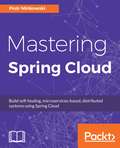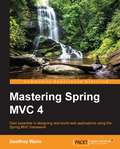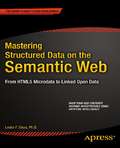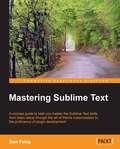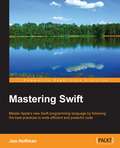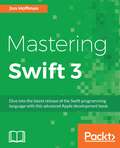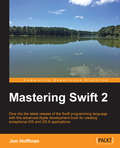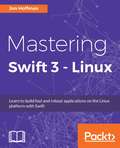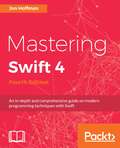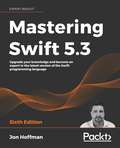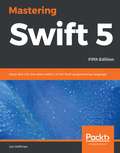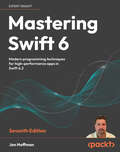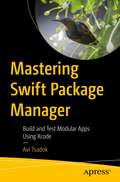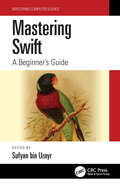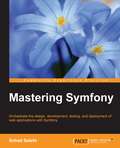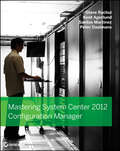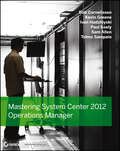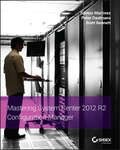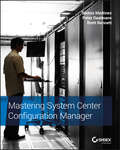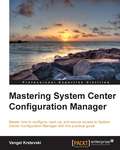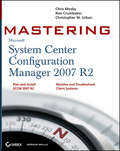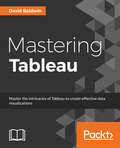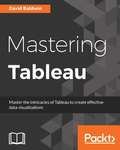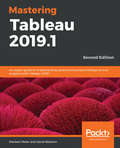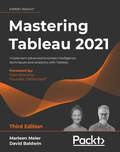- Table View
- List View
Mastering Spring Cloud: Build self-healing, microservices-based, distributed systems using Spring Cloud
by Piotr MińkowskiLearn how to build, test, secure, deploy, and efficiently consume services across distributed systems.Key Features- Explore the wealth of options provided by Spring Cloud for wiring service dependencies in microservice systems.- Create microservices utilizing Spring Cloud's Netflix OSS- Architect your cloud-native data using Spring Cloud.Book DescriptionDeveloping, deploying, and operating cloud applications should be as easy as local applications. This should be the governing principle behind any cloud platform, library, or tool. Spring Cloud–an open-source library–makes it easy to develop JVM applications for the cloud. In this book, you will be introduced to Spring Cloud and will master its features from the application developer's point of view. This book begins by introducing you to microservices for Spring and the available feature set in Spring Cloud. You will learn to configure the Spring Cloud server and run the Eureka server to enable service registration and discovery. Then you will learn about techniques related to load balancing and circuit breaking and utilize all features of the Feign client. The book now delves into advanced topics where you will learn to implement distributed tracing solutions for Spring Cloud and build message-driven microservice architectures. Before running an application on Docker container s, you will master testing and securing techniques with Spring Cloud.What you will learn- Abstract Spring Cloud's feature set- Create microservices utilizing Spring Cloud's Netflix OSS- Create synchronous API microservices based on a message-driven architecture.- Explore advanced topics such as distributed tracing, security, and contract testing.- Manage and deploy applications on the production environment Who this book is forThis book appeals to developers keen to take advantage of Spring cloud, an open source library which helps developers quickly build distributed systems. Knowledge of Java and Spring Framework will be helpful, but no prior exposure to Spring Cloud is required.
Mastering Spring MVC 4
by Geoffroy WarinGain expertise in designing real-world web applications using the Spring MVC framework About This Book * Design your own Spring web applications using tools such as Spring Boot and Spring Tool Suite * Secure your developments with easy-to-write, reliable unit and end-to-end tests * Deploy your application on the cloud for free and invite the whole world to see Who This Book Is For This book is perfect for developers who are familiar with the fundamentals of Spring programming and are eager to deepen their web development skills. Prior knowledge of the Spring MVC framework is recommended. What You Will Learn * Set up your own web application using Spring Boot and Spring Tool Suite * Discover the MVC architecture and the different tools along with navigating between views * Design complex advanced-level forms and validate the model * Craft a RESTful application with a meaningful API and error messages * Create maintainable unit and acceptance tests * Secure your application while allowing it to scale * Optimize your requests with caching, ETags, and asynchronous responses * Deploy the web application to the cloud in a snap In Detail Spring MVC is the ideal tool to build modern web applications on the server side. With the arrival of Spring Boot, developers can really focus on the code and deliver great value, leveraging the rich Spring ecosystem with minimal configuration. Spring makes it simple to create RESTful applications, interact with social services, communicate with modern databases, secure your system, and make your code modular and easy to test. It is also easy to deploy the result on different cloud providers. Mastering Spring MVC will take you on a journey from developing your own web application to uploading it on the cloud. You begin by generating your own Spring project using Spring Tool suite and Spring Boot. As you develop an advanced-level interactive application that can handle file uploads as well as complex URLs, you will dive into the inner workings of Spring MVC and the principles of modern web architectures. You will then test, secure, and optimize your Spring web application and design RESTful services that will be consumed on the frontend. Finally, when everything is ready, you will release your application on a cloud provider and invite everyone to see. Style and approach An iterative hands-on approach in a conversational and easy-to-follow style. Each chapter will improve on the work done in the previous one until the application is ready to be released.
Mastering Structured Data on the Semantic Web
by Leslie F. SikosA major limitation of conventional web sites is their unorganized and isolated contents, which is created mainly for human consumption. This limitation can be addressed by organizing and publishing data, using powerful formats that add structure and meaning to the content of web pages and link related data to one another. Computers can "understand" such data better, which can be useful for task automation. The web sites that provide semantics (meaning) to software agents form the Semantic Web, the Artificial Intelligence extension of the World Wide Web. In contrast to the conventional Web (the "Web of Documents"), the Semantic Web includes the "Web of Data", which connects "things" (representing real-world humans and objects) rather than documents meaningless to computers. Mastering Structured Data on the Semantic Web explains the practical aspects and the theory behind the Semantic Web and how structured data, such as HTML5 Microdata and JSON-LD, can be used to improve your site''s performance on next-generation Search Engine Result Pages and be displayed on Google Knowledge Panels. You will learn how to represent arbitrary fields of human knowledge in a machine-interpretable form using the Resource Description Framework (RDF), the cornerstone of the Semantic Web. You will see how to store and manipulate RDF data in purpose-built graph databases such as triplestores and quadstores, that are exploited in Internet marketing, social media, and data mining, in the form of Big Data applications such as the Google Knowledge Graph, Wikidata, or Facebook''s Social Graph. With the constantly increasing user expectations in web services and applications, Semantic Web standards gain more popularity. This book will familiarize you with the leading controlled vocabularies and ontologies and explain how to represent your own concepts. After learning the principles of Linked Data, the five-star deployment scheme, and the Open Data concept, you will be able to create and interlink five-star Linked Open Data, and merge your RDF graphs to the LOD Cloud. The book also covers the most important tools for generating, storing, extracting, and visualizing RDF data, including, but not limited to, Protégé, TopBraid Composer, Sindice, Apache Marmotta, Callimachus, and Tabulator. You will learn to implement Apache Jena and Sesame in popular IDEs such as Eclipse and NetBeans, and use these APIs for rapid Semantic Web application development. Mastering Structured Data on the Semantic Web demonstrates how to represent and connect structured data to reach a wider audience, encourage data reuse, and provide content that can be automatically processed with full certainty. As a result, your web contents will be integral parts of the next revolution of the Web. What you''ll learn Extend your markup with machine-readable annotations and get your data to the Google Knowledge Graph Represent real-world objects and persons with machine-interpretable code Develop Semantic Web applications in Java Reuse and interlink structured data and create LOD datasets Who this book is for The book is intended for web developers and SEO experts who want to learn state-of-the-art Search Engine Optimization methods using machine-readable annotations and machine-interpretable Linked Data definitions. The book will also benefit researchers interested in automatic knowledge discovery. As a textbook on Semantic Web standards powered by graph theory and mathematical logic, the book could also be used as a reference work for computer science graduates and Semantic Web researchers. Table of Contents 1. Introduction to the Semantic Web 2. Knowledge Representation 3. Linked Open Data 4. Semantic Web Development Tools 5. Semantic Web Services 6. Graph Databases 7. Querying 8. Big Data Applications 9. Use Cases
Mastering Sublime Text
by Dan PelegMastering Sublime Text is an easy-to-understand, step-by-step guide for learning all of the features of Sublime Text, including author tips and tricks. Every topic includes code examples and highlighted screenshots to make it easier to understand.This book is for developers with experience in any type of programming language, and for those who want to start using Sublime Text or perfect their existing skills. No knowledge of Sublime Text or any other code editor or IDE is expected.
Mastering Swift
by Jon HoffmanIf you are a developer that learns best by looking at, and working with, code, then this book is for you. A basic understanding of Apple's tools is beneficial but not mandatory.
Mastering Swift
by Jon HoffmanIf you are a developer that learns best by looking at, and working with, code, then this book is for you. A basic understanding of Apple's tools is beneficial but not mandatory.
Mastering Swift 2
by Jon HoffmanDive into the latest release of the Swift programming language with this advanced Apple development book for creating exceptional iOS and osX applicationsAbout This BookHarness the latest and most advanced features of Swift 2 to develop quality iOS and OSX applicationsComprehensive coverage of all the advanced features of Swift and guidance on advanced design techniquesDive deep into protocol extensions, learn new error handling model, and use featured Swift design patterns to write more efficient codeWho This Book Is ForThis book is for developers that want to dive into the newest version of Swift. If you want in-depth knowledge of some of the most sophisticated elements of Swift development including protocol extensions, error-handling, design patterns, and concurrency, Mastering Swift 2 gives you guidance on how to use and apply them in your own projects.What You Will LearnDive into the core components of Swift 2 including operators, collections, control flow, and functionsCreate and use classes, structures, and enums including object-oriented topics such as inheritance, protocols, and extensionsDevelop a practical understanding of subscripts, optionals, and closuresLearn how to use the new protocol extension and error handling features of Swift 2Add concurrency to your applications using Grand Central DispatchMaster Objective-C interoperability with Mix and MatchAccess network resources using SwiftImplement various standard design patterns in the Swift languageIn DetailAt their Worldwide Developer's conference (WWDC) in 2015, Apple announced Swift 2, a major update to the innovative programming language they first unveiled to the world the year before. Swift 2 features exciting enhancements to the original iteration of Swift, acting, as Apple put it themselves as “a successor to the C and Objective-C languages.” – This book demonstrates how to get the most from these new features, and gives you the skills and knowledge you need to develop dynamic iOS and OS X applications.Learn how to harness the newest features of Swift 2 todevelop advanced applications on a wide range of platforms with this cutting-edge development guide. Exploring and demonstrating how to tackle advanced topics such as Objective-C interoperability, ARC, closures, and concurrency, you'll develop your Swift expertise and become even more fluent in this vital and innovative language. With examples that demonstrate how to put the concepts into practice, and design patterns and best practices, you'll be writing better iOS and OSX applications in with a new level of sophistication and control.Style and approachThis book takes an example-based approach where each concept covered is supported by example code to not only give you a good understanding of the concept, but also to demonstrate how to properly implement it.
Mastering Swift 3 - Linux
by Jon HoffmanLearn to build fast and robust applications on the Linux platform with Swift About This Book • Create robust applications by building a strong foundation in the Swift Language • Utilize Swift 3 on the embedded Linux platform for IoT and Robotic projects • Build more flexible and high-performing applications on desktop, server, and embedded Linux platforms Who This Book Is For This book is for Linux developers who are interested in quickly learning how to use Swift to create exciting applications on Linux platforms. What You Will Learn • Install Swift on the Linux platform • Explore the power of the Swift language • Get to know the proper design techniques • Understand Swift's new Core Library • Implement popular design patterns with Swift • Integrate C libraries with Swift • Using Swift on Single-Board Computers • Learn how to add concurrency to your application with Grand Central Dispatch • Learn how to work with Swift Generics • Learn how to use the Protocol-Oriented design paradigm In Detail Swift is a modern, fast, and safe programming language created by Apple. Writing Swift is interactive and fun, the syntax is concise yet expressive, and the code runs lightning-fast. Swift's move to open source has been embraced with open arms and has seen increased adoption in the Linux platform. Our book will introduce you to the Swift language, further delving into all the key concepts you need to create applications for desktop, server, and embedded Linux platforms. We will teach you the best practices to design an application with Swift 3 via design patterns and Protocol-Oriented Programming. Further on, you will learn how to catch and respond to errors within your application. When you have gained a strong knowledge of using Swift in Linux, we'll show you how to build IoT and robotic projects using Swift on single board computers. By the end of the book, you will have a solid understanding of the Swift Language with Linux and will be able to create your own applications with ease. Style and approach This easy-to-follow, code-rich guide is filled with examples that demonstrate how to put the concepts into practice. You'll also get design patterns and best practices to get you writing better applications on the Linux platform.
Mastering Swift 4 - Fourth Edition
by Jon HoffmanDive into the latest release of the Swift programming language with this advanced development book for building highly performant applications. About This Book • Harness the latest and most advanced features of Swift 4 to develop quality iOS and macOS applications • Comprehensive coverage of all the advanced features of Swift and guidance on advanced design techniques • Dive deep into protocol extensions, learn new error handling model, and use featured Swift design patterns to write more efficient code • Get to grips with advanced design techniques to write smarter, cleaner Swift code Who This Book Is For This book is for developers who want to delve into the newest version of Swift. If you are a developer who learns best by looking at and working with code, then this book is for you. A basic understanding of Apple's tools is beneficial but not mandatory. What You Will Learn • Delve into the core components of Swift 4.0, including operators, collections, control flows, and functions • Create and use classes, structures, and enumerations • Understand protocol-oriented design and see how it can help you write better code • Develop a practical understanding of subscripts and extensions • Add concurrency to your applications using Grand Central Dispatch and Operation Queues • Implement generics and closures to write very flexible and reusable code • Make use of Swift's error handling and availability features to write safer code In Detail Swift is the definitive language for Apple development today. It's a vital part of any iOS and macOS developer's skillset, helping them to build the most impressive and popular apps on the App Store—the sort of apps that are essential to iPhone and iPad users every day. With version 4.0, the Swift team has added new features to improve the development experience, making it easier to get the results you want and customers expect. Inside, you'll find the key features of Swift 4.0 and quickly learn how to use the newest updates to your development advantage. From Objective-C interoperability and ARC to closures and concurrency, this advanced Swift guide will develop your expertise and help you become fluent in this vital programming language. We'll give you an in-depth knowledge of some of the most sophisticated elements of Swift development, including protocol extensions, error-handling, design patterns, and concurrency. We'll guide you on how to use and apply them in your own projects. You'll see how to leverage the power of protocol-oriented programming to write flexible and easier-to-manage code. Style and Approach A Step-by-step advanced guide
Mastering Swift 5.3: Upgrade your knowledge and become an expert in the latest version of the Swift programming language, 6th Edition
by Jon HoffmanA comprehensive guide for programming enthusiasts who wish to gain a firm command of the fundamentals and advanced Swift conceptsKey FeaturesSixth edition of this bestselling book, improved and updated to cover the latest version of the Swift 5.3 programming languageGet to grips with popular and modern design techniques to write easy-to-manage Swift codeUse core Swift features such as concurrency, generics, and copy-on-write in your codeBook DescriptionOver the years, Mastering Swift has proven itself among developers as a popular choice for an in-depth and practical guide to the Swift programming language. This sixth edition comes with the latest features, an overall revision to align with Swift 5.3, and two new chapters on building swift from source and advanced operators.From the basics of the language to popular features such as concurrency, generics, and memory management, this in-depth guide will help you develop your expertise and mastery of the language.As you progress, you will gain practical insights into some of the most sophisticated elements in Swift development, including protocol extensions, error handling, and closures. The book will also show you how to use and apply them in your own projects. In later chapters, you will understand how to use the power of protocol-oriented programming to write flexible and easier-to-manage code in Swift. Finally, you will learn how to add the copy-on-write feature to your custom value types, along with understanding how to avoid memory management issues caused by strong reference cycles.By the end of this Swift book, you will have mastered the Swift 5.3 language and developed the skills you need to effectively use its features to build robust applications.What you will learnUnderstand core Swift components, such as operators, collections, control flows, and functionsIdentify how and when to use classes, structures, and enumerationsUse protocol-oriented design with extensions to write easy-to-manage codeLeverage design patterns with Swift to solve commonly occurring design problemsApply copy-on-write for your custom value types to improve performanceAdd concurrency to your applications using Grand Central Dispatch and operation queuesImplement generics to write flexible and reusable codeWho this book is forThis book is for beginners with a basic understanding of programming and experienced developers looking to learn Swift programming. Familiarity with Apple's tools will be beneficial but not mandatory. All examples should also work on the Linux and Windows platforms
Mastering Swift 5: Deep dive into the latest edition of the Swift programming language, 5th Edition
by Jon HoffmanHarness the power of the latest edition with this in-depth and comprehensive guide to the Swift languageKey FeaturesFifth edition of this bestselling book, improved and updated to cover the latest version of the Swift 5 programming languageGet to grips with popular and modern design techniques to write easy-to-manage Swift codeLearn how to use core Swift features such as concurrency, generics, and copy-on-write in your codeBook DescriptionOver the years, the Mastering Swift book has established itself amongst developers as a popular choice as an in-depth and practical guide to the Swift programming language. The latest edition is fully updated and revised to cover the new version: Swift 5.Inside this book, you'll find the key features of Swift 5 easily explained with complete sets of examples. From the basics of the language to popular features such as concurrency, generics, and memory management, this definitive guide will help you develop your expertise and mastery of the Swift language.Mastering Swift 5, Fifth Edition will give you an in-depth knowledge of some of the most sophisticated elements in Swift development, including protocol extensions, error handling, and closures. It will guide you on how to use and apply them in your own projects.Later, you'll see how to leverage the power of protocol-oriented programming to write flexible and easier-to-manage code. You will also see how to add the copy-on-write feature to your custom value types and how to avoid memory management issues caused by strong reference cycles.What you will learnUnderstand core Swift components, including operators, collections, control flows, and functionsLearn how and when to use classes, structures, and enumerationsUnderstand how to use protocol-oriented design with extensions to write easier-to-manage codeUse design patterns with Swift, to solve commonly occurring design problemsImplement copy-on-write for you custom value types to improve performanceAdd concurrency to your applications using Grand Central Dispatch and Operation QueuesImplement generics to write flexible and reusable codeWho this book is forThis book is for developers who want to delve into the newest version of Swift. If you are a developer and learn best by looking at and working with code, then this book is for you. A basic understanding of Apple's tools would be beneficial but not mandatory. All examples should work on the Linux platform as well.
Mastering Swift 6: Modern programming techniques for high-performance apps in Swift 6.2
by Jon HoffmanBecome proficient in Swift 6 using advanced techniques and modern programming practices to effortlessly build high-performance applicationsKey FeaturesPerfect your application development capabilities using the latest features of Swift 6.2Learn advanced techniques like concurrency, memory management, Generics, and Swift TestingApply best practices in Swift to write clean, scalable, and maintainable codePurchase of the print or Kindle book includes a free PDF eBookBook DescriptionThis seventh edition of Mastering Swift 6 is your ultimate guide to harnessing the full power of Swift. Whether you're aiming to optimize the performance of your applications or looking to explore the exciting new features in Swift 6.2, this book has you covered. The author distills his 28 years of experience in the Engineering and IT fields to help you dive deep into advanced concepts and techniques, such as concurrency, memory management, and Generics, all essential for creating high-performance applications. The chapters take you on a flexible journey, covering Swift 6.2’s newest features alongside advanced programming topics such as reflection, concurrency, and Generics. Packed with best practices, testing strategies, and modern programming techniques, this book equips you with the skills to develop scalable, high-performance applications with confidence. Whether you're looking to stay competitive or simply want to excel in Swift 6, this book provides the tools and knowledge you need to succeed.What you will learnOptimize your application's performance to meet the demands of the modern userDevelop readable, well-structured code by utilizing Swift development strategiesUse reflection with the Mirror API to observe your application's execution at runtimeConquer advanced topics, such as concurrency, memory management, and genericsFind out how to use result builders and how to create custom operators in SwiftEffectively test your Swift code with the all-new Swift Testing frameworkWho this book is forThis book is for developers who have a fundamental grasp of the Swift language and aspire to take their development skills to the next level by learning about the advanced topics and techniques of the Swift language. All examples are compatible with Linux, in addition to the MacOS, iOS, iPadOS, VisionOS, and WatchOS platforms, unless otherwise noted.
Mastering Swift Package Manager: Build and Test Modular Apps Using Xcode
by Avi TsadokMaintaining an iOS project often results in thousands of code files scattered around your folders. Did you ever wanted to reuse those files with other projects but found yourself making copies of Swift files? You are not alone! Many iOS developers struggle with this issue as well—unorganized projects, duplicated files, difficulty in testing, and long complication times. This book will show how Swift Package Manager can help you handle these problems by restructuring your project to make it efficient and straightforward. Swift Package Manager isn’t magic, but you’ll likely need a little guidance in using this nifty tool. You'll see how to reorganize projects smartly and efficiently, create your first Swift package, and learn what libraries are in this context. Then share your package with the rest of your projects. Next test your library’s quality. And then take your library to the next level of power by including files that go beyond just code. By going over the methodology of big project organization, you will have the ability to extend your project into the future as Apple sees it. Make no mistake—the path for a modular and flexible project is not easy. With the help of Swift Package Manager, it becomes possible and worth it. What You'll LearnCreate a Swift package both from the command line and from Xcode Manage Swift packages in public and private Git repositories Build test suites to test integrations between packagesWho This Book Is For Senior iOS developers and team leaders who already have professional experience with Swift.
Mastering Swift: A Beginner's Guide (Mastering Computer Science)
by Sufyan Bin UzayrIf you want to become an iOS developer, you have made an excellent choice with this book. Swift holds a significant position in the iOS industry because of the long list of features it serves. It is user-friendly, has great community support, and offers a greater extent of customization. As a result, we can observe a sharp increase in the market demand for developing Apple mobile applications, and with that, companies search for smart developers with the right skill set. Mastering Swift introduces Apple’s excellent Swift standard library style and incorporates usage feedback across multiple Swift projects. However, it should be regarded as a living, changeable document and the basis upon which the programming language is implemented. Before going further into the details of the Swift programming language, the book briefly explains the basic information about the language. It is a high-level language created to develop multifaceted iOS applications that cater to diverse needs of different social and business domains. It is meant to develop high-end apps with multiple complexities. But since it is very close to Objective C, it is easy to code and understand. This feature also makes it incredibly friendly to beginners. Moreover, it is equally compatible with the iPhone, the iPad, Apple Watch, MacBook, and Apple TV, and it can be applied to develop equally efficient and scalable apps for them. This book in the Mastering series encircles all the essential aspects of Swift and explores why this programming language is the future for iOS app development. Different from other languages, it requires fewer lines to activate any feature. This paves the way for a shorter development cycle and saves a lot of precious resources. Further, as one of the most reliable iOS programming languages it supports dynamic libraries that indicate executable bits of code that you can link to an application. Because of such support, Swift apps can interoperate with the newest version of the language to make the app irreplaceable. Swift is a language that was not designed but deliberately made open source so as to invite community input, allowing the product to grow and to mature over the years. This could possibly be the most crucial aspect of Swift. As people become more aware of its potential to be used in servers, web frameworks were more willing to support the demand. Owing to its popularity and significance, its adoption rate in Apple’s rivals remains very high. Whether you are a beginner or an advanced learner, if you are planning for iOS app development through Swift, this book can help with the high-domain expertise and experienced resources. Without a doubt, the developers that create native apps are not going to abandon Swift anytime soon. However, it seems like something must evolve for it to keep growing constantly. We believe that Swift is indeed the future for iOS app developers. And if you are convinced and want to start learning the programming language right away, then this book is what you’re looking for. Learn more about our other Mastering titles at: https://www.routledge.com/Mastering-Computer-Science/book-series/MCS
Mastering Symfony
by Sohail SalehiOrchestrate the designing, development, testing, and deployment of web applications with Symfony About This Book * Create a robust and reliable Symfony development pipeline using Amazon's cloud platform * Cut development and maintenance costs by defining crystal clear features and possible scenarios for each feature before implementation * Follow detailed examples provided in each chapter to create a task management application Who This Book Is For If you are a PHP developer with some experience in Symfony and are looking to master the framework and use it to its full potential, then this book is for you. Though experience with PHP, object-oriented techniques, and Symfony basics is assumed, this book will give you a crash course on the basics and then proceed to more advanced topics. What You Will Learn * Install and configure Symfony and required third-party bundles to develop a task management application * Set up a continuous integration server to orchestrate automatic builds every time you add a new feature to your project * Reduce maintenance costs dramatically using Behaviour Driven Development (BDD) * Create a slick user interface using the Bootstrap framework * Design robust business logic using Doctrine * Build a comprehensive dashboard and secure your project using the Sonata project * Improve performance using Redis, Memcache, and Varnish * Create customized Symfony commands and add them to your console In Detail In this book, you will learn some lesser known aspects of development with Symfony, and you will see how to use Symfony as a framework to create reliable and effective applications. You might have developed some impressive PHP libraries in other projects, but what is the point when your library is tied to one particular project? With Symfony, you can turn your code into a service and reuse it in other projects. This book starts with Symfony concepts such as bundles, routing, twig, doctrine, and more, taking you through the request/response life cycle. You will then proceed to set up development, test, and deployment environments in AWS. Then you will create reliable projects using Behat and Mink, and design business logic, cover authentication, and authorization steps in a security checking process. You will be walked through concepts such as DependencyInjection, service containers, and services, and go through steps to create customized commands for Symfony's console. Finally, the book covers performance optimization and the use of Varnish and Memcached in our project, and you are treated with the creation of database agnostic bundles and best practices. Style and approach A step-by-step guide to mastering Symfony while developing a task management application. Each chapter comes with detailed examples.
Mastering System Center 2012 Configuration Manager
by Peter Daalmans Kent Agerlund Steve Rachui Santos MartinezExpert coverage of Microsoft's highly anticipated network software deployment toolThe latest version of System Center Configuration Manager (SCCM) is a dramatic update of its predecessor Configuration Manager 2007, and this book offers intermediate-to-advanced coverage of how the new SCCM boasts a simplified hierarchy, role-based security, a new console, flexible application deployment, and mobile management. You'll explore planning and installation, migrating from SCCM 2007, deploying software and operating systems, security, monitoring and troubleshooting, and automating and customizing SCCM 2012 with scripts. Features an unparalleled team of authors, two of whom are insiders at Microsoft and have worked with SCCM since nearly its inceptionProvides in-depth coverage and offers a hands-on approach to learning all there is to know about SCCMExplores why SCCM 2012 is the most significant update in its 16-year historyPacked with real-world scenarios to show you how to use SCCM in various contexts, Mastering System Center Configuration Manager 2012 covers all aspects of this powerful and complete network software deployment tool.
Mastering System Center 2012 Operations Manager
by Telmo Sampaio Bob Cornelissen Kevin Greene Paul Keely Ivan Hadzhiyski Samuel M. AllenAn essential guide on the latest version of Microsoft's server management tool Microsoft's powerful Mastering System Center 2012 Operations Manager introduces many exciting new and enhanced feature sets that allow for large-scale management of mission-critical servers. This comprehensive guide provides invaluable coverage to help organizations monitor their environments across computers, network, and storage infrastructures while maintaining efficient and effective service levels across their applications. Provides intermediate and advanced coverage of all aspects of Systems Center 2012 Operations Manager, including designing, planning, deploying, managing, maintaining, and scripting Operations Manager Offers a hands-on approach by providing many real-world scenarios to show you how to use the tool in various contexts Anchors conceptual explanations in practical application Mastering System Center 2012 Operations Manager clearly shows you how this powerful server management tool can best be used to serve your organization's needs.
Mastering System Center 2012 R2 Configuration Manager
by Peter Daalmans Santos Martinez Brett BennettInvaluable coverage on all aspects of System Center 2012 R2 Configuration ManagerCompletely updated for System Center 2012 R2 Configuration Manager, this comprehensive book provides intermediate and advanced coverage of all aspects of the product, including planning and installation, migrating from previous versions of Configuration Manager, deploying software and operating systems, security, monitoring and troubleshooting, and automating and customizing. Provides numerous real-world scenarios to show you how to use the tool in various contextsExplores planning and installation and migrating from SCCM 2007Walks you through deploying software and operating systems, security, monitoring, and troubleshootingDemonstrates automating and customizing SCCM 2012 with scriptsThis essential book provides you with all the information you need to get savvy with System Center 2012 R2 Configuration Manager.
Mastering System Center Configuration Manager
by Peter Daalmans Santos Martinez Brett BennettGet up to date quickly with clear, expert coverage of SCCM 2016 Mastering System Center Configuration Manager provides comprehensive coverage of Microsoft's powerful network software deployment tool, with a practical hands-on approach. Written by Santos Martinez, Peter Daalmans, and Brett Bennett, this guide walks you through SCCM 2016 with in-depth explanations anchored in real-world applications to get you up to speed quickly. Whether you're planning a new installation or migrating from a previous version of Configuration Manager, this book provides clear instruction and expert insight to get the job done right. Fully aligned with the latest release, the discussion covers the newest tools and features with examples that illustrate utility in a variety of contexts. System Center Configuration Manager (formerly SMS) is one of Microsoft's flagship products; the 2016 release has been updated with better Windows 10 and Windows Server 2016 compatibility, improved tools for managing non-Microsoft mobile devices in the cloud, and more. This book provides start-to-finish coverage and expert guidance on everything you need to get your system up to date. Deploy software and operating systems Automate processes and customize configurations Monitor performance and troubleshoot issues Manage security in the cloud and on Virtual Machines SCCM 2016 improves your ability to handle the bring-your-own-device influx in managing mobile, streamlining the latest hiccup right into the everyday workflow. Mastering System Center Configuration Manager provides the practical coverage you need to get up and running seamlessly.
Mastering System Center Configuration Manager
by Vangel KrstevskiThis book is perfect for IT administrators who are looking to enhance their skills on system and asset management. A fair understanding of the core elements and applications related to SCCM would be helpful.
Mastering System Center Configuration Manager 2007 R2
by Chris Mosby Ron D. Crumbaker Christopher W. UrbanMastering System Center Configuration Manager 2007 provides intermediate and advanced coverage of all aspects of the product, including planning and installation, upgrading Systems Management Server 2003, deploying software and operating systems, security, monitoring and troubleshooting, and automating and customizing SCCM 2007 with scripts.The authors take a hands-on approach by providing many real-world scenarios to show readers how to use the tool in various contexts. This anchors the conceptual explanations in practical application. This book's web site will contain a collection of ready-to-use scripts with directions for implementing them in network systems.
Mastering Tableau
by David BaldwinMaster the intricacies of Tableau to create effective data visualizations About This Book * Arm yourself with an arsenal of advanced chart types and geocoding to efficiently and engagingly present information * Map a grid over a network node diagram and use that grid to demonstrate loads, processing time, and more in Tableau * Integrate R with Tableau by utilizing R functions, libraries, and saved models Who This Book Is For If you are a business analyst without developer-level programming skills, then this book is for you. You are expected to have at least a fundamental understanding of Tableau and basic knowledge of joins, however SQL knowledge is not assumed. You should have basic computer skills, including at least moderate Excel proficiency. What You Will Learn * Create a worksheet that can display the current balance for any given period in time * Recreate a star schema from in a data warehouse in Tableau * Combine level of detail calculations with table calculations, sets, and parameters * Create custom polygons to build filled maps for area codes in the USA * Visualize data using a set of analytical and advanced charting techniques * Know when to use Tableau instead of PowerPoint * Build a dashboard and export it to PowerPoint In Detail Tableau has emerged as one of the most popular Business Intelligence solutions in recent times, thanks to its powerful and interactive data visualization capabilities. This book will empower you to become a master in Tableau by exploiting the many new features introduced in Tableau 10.0. You will embark on this exciting journey by getting to know the valuable methods of utilizing advanced calculations to solve complex problems. These techniques include creative use of different types of calculations such as row-level, aggregate-level, and more. You will discover how almost any data visualization challenge can be met in Tableau by getting a proper understanding of the tool's inner workings and creatively exploring possibilities. You'll be armed with an arsenal of advanced chart types and techniques to enable you to efficiently and engagingly present information to a variety of audiences through the use of clear, efficient, and engaging dashboards. Explanations and examples of efficient and inefficient visualization techniques, well-designed and poorly designed dashboards, and compromise options when Tableau consumers will not embrace data visualization will build on your understanding of Tableau and how to use it efficiently. By the end of the book, you will be equipped with all the information you need to create effective dashboards and data visualization solutions using Tableau. Style and approach This book takes a direct approach, to systematically evolve to more involved functionalities such as advanced calculation, parameters & sets, data blending and R integration. This book will help you gain skill in building visualizations previously beyond your capacity.
Mastering Tableau
by David Baldwin<P><P>Mastering Tableau will help you improve your Tableau skills by providing: <P><P>A quick primer to refresh your skills and ensure a sound foundation <P><P>An understanding of how to effectively structure data for best results in Tableau <P><P>Techniques for using Tableau to explore and cleanse data <P><P>A deep dive into Table calculations and LOD calculations <P><P>Insight on various visualization types, how to build them,and when to use them <P><P>Mapping techniques both native and external to Tableau <P><P>Guidance on effective and advanced dashboarding <P><P>Instruction on using Tableau as an effective presentation tool - with or without PowerPoint <P><P>Techniques for improving performance <P><P>Best practices for interfacing with Tableau Server <P><P>A basic understanding of integrating effectively with R
Mastering Tableau 2019.1: An expert guide to implementing advanced business intelligence and analytics with Tableau 2019.1, 2nd Edition
by David Baldwin Marleen MeierBuild, design and improve advanced business intelligence solutions using Tableau’s latest features, including Tableau Prep, Tableau Hyper, and Tableau ServerKey FeaturesMaster new features in Tableau 2019.1 to solve real-world analytics challengesPerform Geo-Spatial Analytics, Time Series Analysis, and self-service analytics using real-life examplesBuild and publish dashboards and explore storytelling using Python and MATLAB integration supportBook DescriptionTableau is one of the leading business intelligence (BI) tools used to solve BI and analytics challenges. With this book, you will master Tableau's features and offerings in various paradigms of the BI domain. This book is also the second edition of the popular Mastering Tableau series, with new features, examples, and updated code. The book covers essential Tableau concepts and its advanced functionalities. Using Tableau Hyper and Tableau Prep, you’ll be able to handle and prepare data easily. You’ll gear up to perform complex joins, spatial joins, union, and data blending tasks using practical examples. Following this, you’ll learn how to perform data densification to make displaying granular data easier. Next, you’ll explore expert-level examples to help you with advanced calculations, mapping, and visual design using various Tableau extensions. With the help of examples, you’ll also learn about improving dashboard performance, connecting Tableau Server, and understanding data visualizations. In the final chapters, you’ll cover advanced use cases such as Self-Service Analytics, Time Series Analytics, and Geo-Spatial Analytics, and learn to connect Tableau to R, Python, and MATLAB. By the end of this book, you’ll have mastered the advanced offerings of Tableau and be able to tackle common and not-so-common challenges faced in the BI domain.What you will learnGet up to speed with various Tableau componentsMaster data preparation techniques using Tableau PrepDiscover how to use Tableau to create a PowerPoint-like presentationUnderstand different Tableau visualization techniques and dashboard designsInteract with the Tableau server to understand its architecture and functionalitiesStudy advanced visualizations and dashboard creation techniquesBrush up on powerful Self-Service Analytics, Time Series Analytics, and Geo-Spatial AnalyticsWho this book is forThis book is designed for business analysts, BI professionals and data analysts who want to master Tableau to solve a range of data science and business intelligence problems. The book is ideal if you have a good understanding of Tableau and want to take your skills to the next level.
Mastering Tableau 2021: Implement advanced business intelligence techniques and analytics with Tableau, 3rd Edition
by David Baldwin Marleen Meier Kate StrachnyiBuild, design, and improve advanced business intelligence solutions using Tableau's latest features, including Tableau Prep Builder, Tableau Hyper, and Tableau ServerKey FeaturesMaster new features in Tableau 2021 to solve real-world analytics challengesPerform geo-spatial, time series, and self-service analytics using real-life examplesBuild and publish dashboards and explore storytelling using Python and R integration supportBook DescriptionTableau is one of the leading business intelligence (BI) tools used to solve data analysis challenges. With this book, you will master Tableau's features and offerings in various paradigms of the BI domain. Updated with fresh topics including Quick Level of Detail expressions, the newest Tableau Server features, Einstein Discovery, and more, this book covers essential Tableau concepts and advanced functionalities. Leveraging Tableau Hyper files and using Prep Builder, you'll be able to perform data preparation and handling easily. You'll gear up to perform complex joins, spatial joins, unions, and data blending tasks using practical examples. Following this, you'll learn how to execute data densification and further explore expert-level examples to help you with calculations, mapping, and visual design using Tableau extensions. You'll also learn about improving dashboard performance, connecting to Tableau Server and understanding data visualization with examples. Finally, you'll cover advanced use cases such as self-service analysis, time series analysis, and geo-spatial analysis, and connect Tableau to Python and R to implement programming functionalities within Tableau. By the end of this Tableau book, you'll have mastered the advanced offerings of Tableau 2021 and be able to tackle common and advanced challenges in the BI domain.What you will learnGet up to speed with various Tableau componentsMaster data preparation techniques using Tableau Prep BuilderDiscover how to use Tableau to create a PowerPoint-like presentationUnderstand different Tableau visualization techniques and dashboard designsInteract with the Tableau server to understand its architecture and functionalitiesStudy advanced visualizations and dashboard creation techniquesBrush up on powerful self-service analytics, time series analytics, and geo-spatial analyticsWho this book is forThis book is designed for business analysts, business intelligence professionals and data analysts who want to master Tableau to solve a range of data science and business intelligence problems. The book is ideal if you have a good understanding of Tableau and want to take your skills to the next level.
